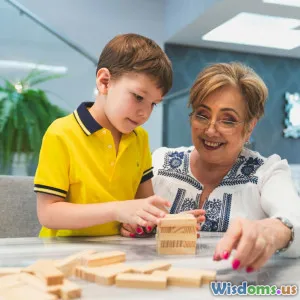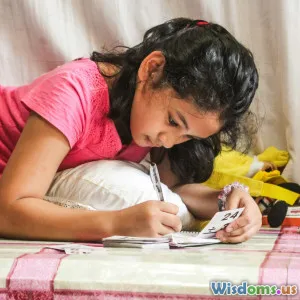
Managing Grandparent Involvement Without Overstepping Boundaries
9 min read Explore strategies to foster healthy grandparent involvement while maintaining clear family boundaries and mutual respect. (0 Reviews)
Managing Grandparent Involvement Without Overstepping Boundaries
Introduction: The Delicate Dance of Grandparent Involvement
Grandparents hold a cherished place in many families, often acting as emotional anchors, wise advisors, and treasured companions to their grandchildren. Yet, the involvement of grandparents can be a double-edged sword. When boundaries are unclear or disregarded, their influence — however well-intentioned — can lead to tension, misunderstandings, or even conflict. Navigating this relationship requires a careful blend of appreciation, communication, and respect.
As families modernize and dynamics shift, the challenge isn’t about keeping grandparents involved but rather managing their role effectively so that everyone’s needs are honored without crossing lines. This article provides actionable insights for parents who want to foster meaningful grandparent relationships while clearly defining boundaries that protect the emotional well-being of their nuclear family.
Understanding the Importance of Grandparent Involvement
The Positive Impact on Children
Studies consistently demonstrate that children with involved grandparents often experience advantages, including emotional support, cultural and family identity, and additional educational guidance. According to research published by the American Psychological Association, children who interact regularly with their grandparents tend to report better mental health and have enhanced social skills.
For instance, Michelle, a mother from Ohio, noted: “My mom’s patience and stories from our family history brought depth to my kids' understanding of who they are.” Such involvement nurtures belonging and strengthens multi-generational bonds.
How Boundaries Can Be Crossed Unintentionally
However, grandparents sometimes overstep in ways that create friction: unsolicited parenting advice, undermining established rules, or interfering in discipline. Often these actions stem from love and a desire to help but may inadvertently convey disrespect towards the parents’ authority.
A 2020 survey by the Pew Research Center found that nearly 35% of parents reported occasional disagreements over grandchild care approaches with grandparents. Such statistics highlight the prevalence of boundary issues yet also underscore that these conflicts can be managed constructively.
Key Strategies for Managing Boundaries Without Sabotaging Relationships
1. Establish Open and Respectful Communication
Clear conversation is foundational. Parents should initiate discussions with grandparents about expectations and family values. Frame the dialogue with affirmation — express appreciation for the role grandparents play.
For example, Samantha, a parent of two from Texas, shared: “When my mom offered advice about screen time, I thanked her for caring and explained our reasoning. It made a tough conversation easier, and she felt included rather than sidelined.”
Use "I" statements to convey feelings without accusatory language, e.g., “I feel concerned when bedtimes vary because it affects our children’s routine.” These techniques promote understanding instead of defensiveness.
2. Define and Agree on Boundaries Early
Early conversations reduce ambiguity. Agree on who makes decisions about discipline, health, education, and lifestyle. Some families create written guidelines as a reminder and reference.
Set mutually agreeable times for childcare involvement, visits, or outings to avoid spontaneous disruptions. Grandparents appreciate transparency about schedules and limits.
3. Involve Grandparents in Family Rituals Without Relinquishing Parental Authority
Invite grandparents to participate in traditions tailored to their interests or strengths — such as storytelling, crafts, or cooking family recipes. This nurtures connection.
However, parents remain custodians of rules and routines. For instance, a grandparent can lead a craft session but not contradict dietary restrictions or bedtimes. This role clarity is key.
4. Handle Conflicts Constructively When Boundaries Are Crossed
If boundaries are strained, address concerns promptly and privately. Avoid public confrontations which can escalate conflicts.
Use empathetic but firm language. For example, “I know your intentions are loving, but when you do X, it makes me feel Y, and I would like us to do Z instead.” Incorporate win-win solutions whenever possible.
5. Seek External Support if Needed
Sometimes, boundary issues involve deeper family dynamics or persistent disputes. Family counseling or mediation with a neutral third party can help reset relationships and provide communication tools.
Real-World Example: The Garcia Family
The Garcias experienced tension when Grandma Rosa began to put their 5-year-old son to bed at her house later than usual, resulting in crankiness and behavioral issues. Instead of avoiding the problem, parents Luis and Maria arranged a heart-to-heart with Rosa.
They said, "We love how much you enjoy babysitting and want to make sure Juan has restful nights. Could we agree on keeping to his 8 pm bedtime with some flexibility on weekends?" Rosa felt valued and understood, agreeing willingly. The adjustment preserved the bond without undermining parenting rules.
The Role of Technology in Maintaining Healthy Boundaries
Technology offers tools to facilitate respectful grandparent involvement. Shared calendars (e.g., Google Calendar) can help schedule visits and childcare duties transparently. Messaging apps enable quick clarifications without pressure.
Virtual family gatherings via platforms like Zoom also broaden interaction when distance or pandemic restrictions limit face-to-face contact, reducing pressure on boundaries and creating shared experiences.
Benefits of Balanced Grandparent Involvement
- Emotional Well-being: Children feel loved and supported from multiple generations.
- Enhanced Family Identity: Grandparents transmit heritage, language, and traditions.
- Support Network: Parents gain allyship in childcare and advice.
- Reduced Parental Stress: Respite care opportunities help parents recharge.
Conversely, well-maintained boundaries reduce anxiety, resentment, and power struggles that can harm relationships.
Conclusion: Cultivating Respectful Grandparent Partnerships
Grandparents are invaluable family assets, yet their involvement flourishes best within thoughtfully negotiated boundaries. Families that communicate openly, empathize with one another’s roles, and collaborate on mutual respect create a harmonious environment benefiting all.
Ultimately, the goal isn’t to erect walls but to build bridges — allowing grandparents to contribute meaningfully without infringing on parental authority. Such balance enriches family life, ensuring that love, not conflict, defines the grandparent-grandchild relationship.
Families embarking on this journey gain more than peace; they harvest deeper connections that thrive across generations.
References:
- American Psychological Association, "The Role of Grandparents in Child Development (2017)."
- Pew Research Center, "Parenting Disagreements with Grandparents Report (2020)."
- Family Therapy Quarterly, "Managing Boundaries in Extended Family Relationships (2018)."
Author’s Note: This article is designed to provide practical, research-backed guidance for families seeking to balance grandparent engagement lovingly and effectively.
Rate the Post
User Reviews
Popular Posts




















